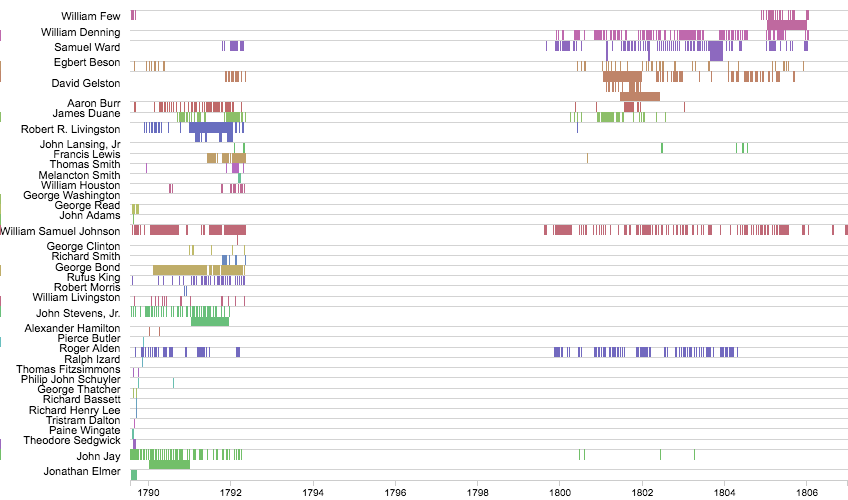A Graph of the Founding Fathers’ Borrowing Frequency at the New York Society Library
To view the data in this graph more closely, click on the image and then zoom in
Despite access to a plethora of historical lending information for all 42 Founding Fathers who visited the New York Society Library, it is still noticeable in the library’s records that some of these men borrowed books at much more frequent rates than did others. A brief perusal of the dataset shows that Founding Fathers William Denning and William Samuel Johnson were popular and consistent patrons of the New York Society Library, while the famous George Washington and John Adams borrowed rarely. Curious about these differences in borrowing frequency, the above data visualization seemed to be an important addition missing from previous research on this topic. This graph and its analysis intend to clarify the overall impact of the New York Society Library on America’s forefathers and support the rest of this project (as perhaps the final installment of this research). Any researchers of the Founding Fathers’ borrowing activity at the New York Society Library may be curious to understand how consistently these men visited the library, as well as in how it could have impacted Founding Fathers as both human beings and scholars.
The “Date Out” and “Date In” data pieces from the New York Society Library’s ledger collection were both used in creating the above Gantt chart of “color chunks” with RAW Graphs. This particular visualization best highlights in color the times in which specific Founding Fathers borrowed books over a large span of years (the entirety of the years for which there were records, 1789-1792 and 1799-1805), and especially focuses on borrowing check-out and return dates. Each separate “color chunk” represents the borrowing time of a single book— from when it was checked out and left the library, to when it was returned. Some of these “color chunks” are thinner than others since some books were checked out for shorter periods of time, while the larger “color chunks” indicate that the text was checked out for a longer period. However, when considering the format of this graph and examining it, it is important to remark a deficiency in the data that it portrays. Though the ledger records for individual borrowers begin with much frequency on the above graph in July of 1789, continue until April 1792, and pick up again in 1799, such a large gap in the visualization data must be explained. The creation of this graph revealed the unfortunate turn of events which took place during the preservation of these ledgers: the New York Society Library lost its borrowing records from the years 1792 to 1799 (“About This Project”). After discovering this shortcoming of the New York Society Library’s ledger collection, it is additionally interesting to research and hypothesize the possible reasons as to why certain Founding Fathers were more active borrowers either before or after this seven-year gap. Perhaps some moved away, died, or became involved in business that pulled them away from New York City’s oldest library.
One example of a Founding Father whose borrowing frequency was higher before 1792 than afterwards is perhaps the most famous of them all: George Washington. He is a somewhat surprising figure out of those who visited the New York Society Library, because despite his important role in Revolutionary American history and plentiful historical evidence of his scholarship, Washington only borrowed two books from the dataset’s collection (Elkins). A probable explanation for this sparse borrowing history could be due to his retirement in Mount Vernon, Virginia in 1797 (during the span of the missing ledger records). His borrowing history waned to a halt after the ledgers were recovered in 1800 because of his passing in the year 1799. The same can be said for the lesser known George Read. A lawyer and politician from New Castle County, Delaware, he checked out a few books in the late 1780s, and then passed in 1798, thus disappearing from New York Society Library records after the gap in data. Although both of these men were patrons and borrowers at the library, neither one spent a great deal of time there (not to mention other American Founding Fathers who were alive from 1789-1805 and never appear in the dataset at all). The New York Society Library was not a definitive resource for every American forefather; 42 examples of legendary borrowers do not make New York Society Library patronage a rule for participation in the United States Congress.
On the other hand, the above visualization also depicts consistent borrowing habits. Another notable member of our collection, William Samuel Johnson, is unique among New York Society Library visitors as the most frequent borrower amongst the Founding Fathers in the library’s ledger collection. His commitment to education appears to have rang true in both his own reading habits and his service to Columbia University as president from 1787-1800 (where he could have used his borrowed books as resources). Furthermore, Johnson is not the sole Founding Father to have significantly utilized and popularized the New York Society Library between 1789-1805. Roger Alden and Aaron Burr both have considerable borrowing frequency both before and after the gap in records. The visual portrayal of the frequency of books checked out by the Founding Fathers not only illustrates the regularity with which these men perused their chosen texts, but also the potential reasoning behind visits to the library itself. As a place where over 40 American Founding Fathers came to read and research (with some Founding Fathers so devoted and punctual as to check a book out one day and return it the very next), the New York Society Library was surely far more popular than many libraries of the 21st century. It was undoubtedly a place of education, scholarship, and revolutionary thought that connected people from all backgrounds- including the Founding Fathers.
